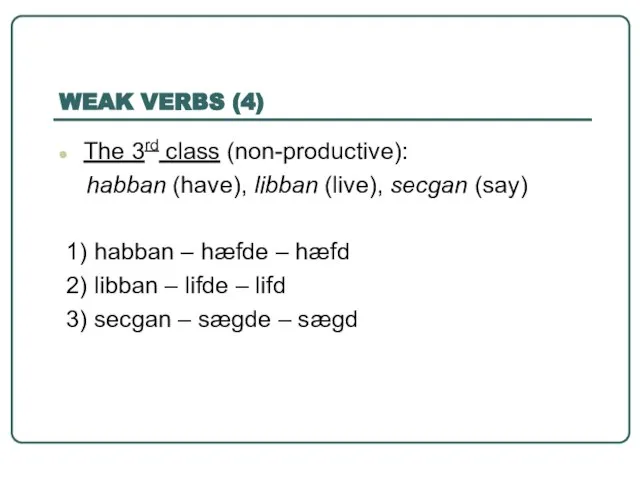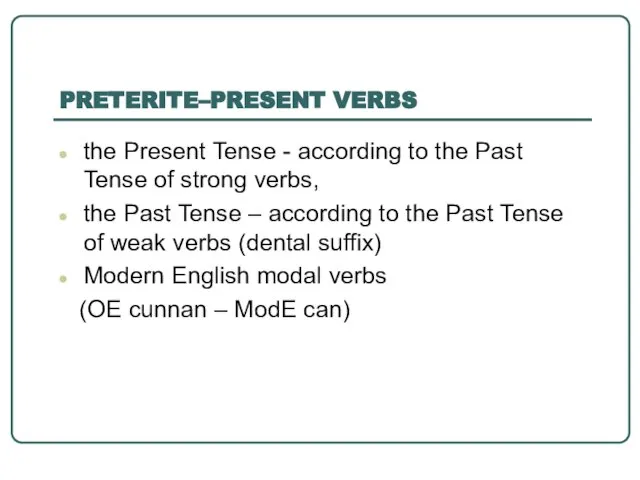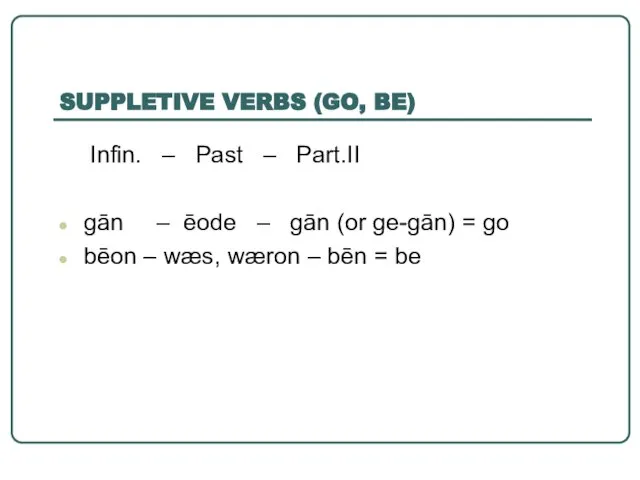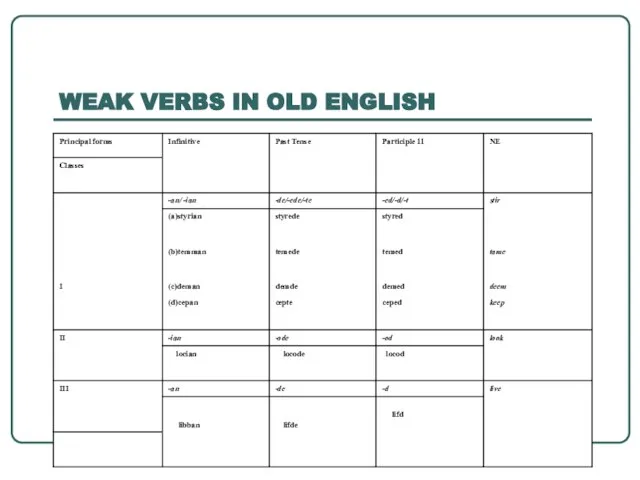Слайд 2GRAMMATICAL CATEGORIES
OF THE VERB
number (singular, plural
Person (1st, 2nd, 3rd

distinguished only in the Singular of the Present Tense)
mood (Imperative, Indicative, Subjunctive)
tense (Present, Past)
Слайд 3NON-FINITE FORMS
Infinitive
OE helpan (Nom.) - OE to helpenne (Dat.)

Participle:
Participle I – present, active
Participle II – past, passive (from the transitive verbs), active (from the intransitive verbs)
Слайд 5MORPHOLOGICAL CLASSIFICATION
OF VERBS
Strong verbs
Weak verbs
Preterit – present verbs
Suppletive verbs
Anomalous,

or irregular verbs
Слайд 6STRONG VERBS
Four principal forms: Infinitive, Past Singular (for the 1st and 3rd

pers.sg.), Past Plural (for the 2nd and plural), Participle II
Seven classes: five classes due to the ablaut (the gradation of root-vowels);
class 6 – quantitative changes (a-ō-o-a);
class 7 – reduplication (the doubling of the root in the Past tense stems)
Слайд 7DIFFERENT ADDED SOUNDS
IN THE CLASSES OF VERBS
1 – i
2 – u
3

– sonorant + h or another consonant
4 – sonorant in the root
5 – noise consonant in the root
6 – quantitative ablaut: IE o - ō, Germ. a – ō
7 – reduplication of the first consonant of the root + ai>e in the Past Tense; the root is a long monophthong or a long diphthong.
Слайд 9WEAK VERBS (1)
Three principal forms: Infinitive, Past,
Participle II
Three classes (dental

suffix –d / -ed; no vowel interchange)
Слайд 10WEAK VERBS (2)
The 1st class (non-productive): derivatives
a) of nouns: dēman

← dōm,
b) of adjectives: fyllan ← full,
c) of the Past Sg of strong verbs (with causative meaning):
sittan – sæt – sæton – seten = sit,
sæt + jan > settan = set
Слайд 11IRREGULAR WEAK VERBS
OF THE 1ST CLASS
tellan (ea ← breaking before -ld);
Þencan

– þōhte – þoht (think)
(*þankjan – þankde – þankd)
Слайд 12WEAK VERBS (3)
The 2nd class (productive): stem-suffix ō
lufian ← *luf-ō-jan

Слайд 13WEAK VERBS (4)
The 3rd class (non-productive):
habban (have), libban (live), secgan

(say)
1) habban – hæfde – hæfd
2) libban – lifde – lifd
3) secgan – sægde – sægd
Слайд 15PRETERITE–PRESENT VERBS
the Present Tense - according to the Past Tense of

strong verbs,
the Past Tense – according to the Past Tense of weak verbs (dental suffix)
Modern English modal verbs
(OE cunnan – ModE can)
Слайд 16SUPPLETIVE VERBS (GO, BE)
Infin. – Past – Part.II
gān – ēode –

gān (or ge-gān) = go
bēon – wæs, wæron – bēn = be















 Как открыть бизнес по продаже духов на разлив с нуля
Как открыть бизнес по продаже духов на разлив с нуля Кто придумал ноль ?
Кто придумал ноль ? Политико-экономические детерминанты развития БеларусиДипломная работа
Политико-экономические детерминанты развития БеларусиДипломная работа История развития взаимоотношений человека с природой
История развития взаимоотношений человека с природой Презентация на тему Особенности мозгового кровообращения
Презентация на тему Особенности мозгового кровообращения  Катехизис - азбука веры
Катехизис - азбука веры Памятка
Памятка Презентация на тему Эстетика постимпрессионизма
Презентация на тему Эстетика постимпрессионизма  Экологические проблемы современной России и пути их решения
Экологические проблемы современной России и пути их решения Методика проведения анализа финансовохозяйственной деятельности предприятия
Методика проведения анализа финансовохозяйственной деятельности предприятия Регуляторная гильотина в сфере высшего образования
Регуляторная гильотина в сфере высшего образования Презентация без названия
Презентация без названия Виды глаголов
Виды глаголов Система работы с родителями новые подходы к воспитательному процессу
Система работы с родителями новые подходы к воспитательному процессу Презентация на тему Методы прерывания беременности Медикаментозный аборт
Презентация на тему Методы прерывания беременности Медикаментозный аборт  Сергиево-Посадскому району 90 лет
Сергиево-Посадскому району 90 лет Презентация по предмету «Klienditeenindus»
Презентация по предмету «Klienditeenindus» Professions
Professions Сертификат социальной безответственности
Сертификат социальной безответственности 7 класс
7 класс Презентация на тему Карбоновые кислоты и их производные
Презентация на тему Карбоновые кислоты и их производные Вихри враждебные
Вихри враждебные Философия Древнего Китая
Философия Древнего Китая Отношения между людьми
Отношения между людьми Детская организация школы №57
Детская организация школы №57 Презентация на тему Грибы- особое царство природы
Презентация на тему Грибы- особое царство природы  Фитнес направления и влияние их на организм
Фитнес направления и влияние их на организм Осенний натюрморт
Осенний натюрморт